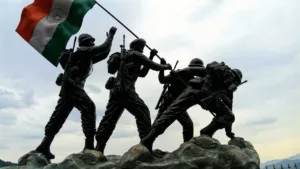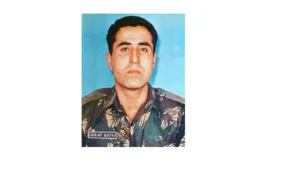Introduction 🌟
The Kargil War stands as a defining chapter in the history of India and Pakistan, unfolding from May to July 1999 in the rugged terrain of Dras, Kargil district, situated in Jammu and Kashmir, and other regions along the Line of Control (LoC).
At the core of this confrontation lay the Line of Control (LoC), the de facto border demarcating Indian-administered Kashmir from its Pakistani-administered counterpart. In a daring move, Pakistani Northern light Infantry troops and militants impersonating as Kashmiri insurgents infiltrated strategic positions on the Indian side of the LoC, setting the stage for a dangerous standoff.
As the dawn of May 1999 broke, the serene mountains echoed with the deafening sound of gunfire, signaling the commencement of the Kargil War codenamed ‘Operation Vijay’ by the Indian Army.

Causes of War – Exposing Pakistan’s Role 🚩:
In early May 1999, vigilant local shepherds detected unusual activities along the Line of Control and promptly alerted the Army. Their timely reports on May 3rd alerted the Indian Army to a potential incursion by Pakistani forces into Indian territory.
Prompted by these alerts, Indian patrols ventured deeper into the region, uncovering telltale signs of enemy presence – abandoned equipment, newly laid tracks. This discovery marked the onset of a clandestine infiltration by Pakistani troops.
Series of Events: Unfolding Dramatically 📜:
- May 3, 1999: Shepherd Alerts 🐑 – Local shepherds in Kargil noticed suspicious movements along the Line of Control, signaling a potential intrusion. Their alert marked the initial indication of an impending conflict.
- May 5, 1999: Discovery and Engagement💥 – Responding to shepherd’s reports, Indian Army patrols encountered Pakistani infiltrators in Kargil, marking the start of a covert operation by Pakistani forces.
- May 10 – May 25, 1999: Escalation ⚔️- As tensions mounted, Pakistan intensified its incursion, targeting Indian Army ammunition dumps in Kargil. Both sides fortified their positions.
- May 26, 1999: Launch of Operation Vijay🚁 – In response, the Indian Army launched ‘Operation Vijay,’ aiming to reclaim occupied territories and expel Pakistani intruders, a decisive move in the conflict.
- May 27 – May 28, 1999: Aerial Strikes ✈️ – The Indian Air Force commenced ‘Operation Safed Sagar,’ conducting airstrikes on Pakistani positions in Kargil, supporting ground forces.
- May 31, 1999: Incurred Losses 💔- Despite Indian advances, the conflict inflicted heavy casualties on both sides, with Pakistani forces downing three Indian aircraft.
- June 1, 1999: Declaration of Escalation📢- Indian Prime Minister Atal Bihari Vajpayee declared a “war-like situation” with Pakistan, underscoring India’s resolve.
- June 5, 1999: Cross-Border Shelling 🛡️- Pakistan intensified its offensive, targeting Indian positions along National Highway-1 in Kashmir and Ladakh.
- June 9, 1999: Revelation of Evidence 📜- India released captured documents from Pakistani soldiers, revealing Pakistan’s direct involvement.
- June 10, 1999: Indian Advances🏞️ – Indian forces made significant gains, capturing key positions in the Batalik Sector.
- June 11, 1999: Return of the Fallen⚔️ – Pakistan returned the bodies of six Indian soldiers from the Jat Regiment.
- June 13, 1999: Diplomatic Pressure 🤝- India released intercepted communications between Pakistani military leaders, exposing Pakistan’s aggressive intentions.
- June 15, 1999: Victories and Counteroffensives 🏆- Indian forces recaptured Tololing Heights and repelled Pakistani counteroffensives.
- June 29, 1999: International Intervention🌍 – Under pressure, Pakistani Prime Minister Nawaz Sharif withdrew troops from Kargil.
- July 4, 1999: Retreat and Unconditional Withdrawal 🕊️ – Pakistani forces began retreating from Indian-administered Kashmir.
- July 12, 1999: Conclusion of Operation Vijay🎉- Indian forces seized control of Dras, concluding ‘Operation Vijay,’ restoring peace.
- July 26, 1999: Official End of Kargil War 🏁 – India emerged victorious, with the conflict officially declared over.
Casualties and Losses during Kargil War☹️:
Indian Official Figures: The operations witnessed a total of 674 Indian soldiers making the ultimate sacrifice, with 1,363 wounded, 1 POW, 1 fighter jet shot down, 1 fighter jet crashed, and 1 helicopter downed.
Pakistani Claims: General Musharraf cited 1,600 casualties.
Indian Claims: Reports suggest 737 to 1,200 killed (with at least 249 bodies recovered in Indian territory) and over 1,000 wounded.
International Intervention🤝:
During the Kargil War, various nations closely monitored the situation and voiced their concerns. Notable responses included:
United States: Urging restraint and peaceful resolution, President Bill Clinton played a pivotal role in diplomatic efforts.
China: Expressing concern about escalating tensions, it called for restraint and dialogue between the two nations.
United Kingdom: Encouraging dialogue, British diplomats engaged with both sides to prevent further escalation.
Russia: Maintaining close communication with India and Pakistan, it supported diplomatic efforts for a peaceful resolution.
Other Nations🌍: Countries worldwide, including those in the European Union, expressed concern and called for an end to hostilities. International bodies like the United Nations monitored the situation and advocated for peace.
Israel’s Timely Support:
Israel extended crucial assistance to India during the Kargil conflict, primarily through intelligence and military aid.
Intelligence Sharing🔍: Renowned for surveillance and reconnaissance expertise, Israel’s intelligence agencies provided actionable intelligence to Indian forces regarding Pakistani troop movements in Kargil. This intelligence played a pivotal role in India’s strategic planning.
Military Equipment🛠️: Israel supplied India with advanced military hardware, including unmanned aerial vehicles (UAVs) and laser-guided munitions, enhancing India’s reconnaissance capabilities and striking power.
Gallantry Awards to the War Heroes🎖️:
Numerous soldiers displayed exceptional courage during the Kargil conflict, earning honors and awards for their bravery and service to the nation. Notable awards include:
Param Vir Chakra (PVC): India’s highest military honor awarded for extraordinary valor. Recipients include Captain Vikram Batra, Rifleman Sanjay Kumar, Subedar Major Y S Yadav, and Lieutenant Manoj Kumar Pandey.

Aftermath of Kargil Conflict:
The Kargil conflict significantly impacted diplomatic efforts outlined in the Lahore Declaration of 1999 between India and Pakistan.
Setback to Peace Efforts🤝: The conflict dealt a blow to the Lahore Declaration, hindering attempts to resolve issues through dialogue.
Erosion of Trust💔: Pakistan’s unilateral aggression undermined trust established during the Lahore Summit.
Diplomatic Fallout🌐: Relations strained, leading to a breakdown in communication and renewed hostility.
International Scrutiny 🌍: The international community expressed concern and urged restoration of peace.
Long-Term Implications📉: Deep-rooted mistrust prolonged tensions, highlighting unresolved disputes.
Conclusion🌟
As we conclude this journey through the Kargil War, we’re reminded of the bravery and sacrifice of our soldiers. Their courage and dedication embody the spirit of our nation. Though the war has ended, their memory inspires us to uphold our values – unity, resilience, and patriotism. Let’s honor their legacy by working towards a peaceful and prosperous future.
Kargil War Hereos:
Along with Paramveer Chakra Awardee, there are some other soldiers who have shown exemplary courage and valor in the battle field. These heroes are awarded for
Mahavir Chakra (MVC): The Mahavir Chakra stands as India’s second-highest military decoration, bestowed upon individuals who display remarkable courage and valor in the face of the enemy, regardless of the battlefield – be it on land, at sea, or in the skies.
1 Major Rajesh Singh Adhikari (18 Grenadiers), 2. Lieutenant Balwan Singh (18 Grenadiers), 3. Major Vivek Gupta (2 Rajputana Rifles), 4. Major Padmapani Acharya (2 Rajputana Rifles), 5. Captain Neikezhakuo Kenguruse (2 Rajputana Rifles), 6. Naik Digendra Kumar (2 Rajputana Rifles), 7. Major Sonan Wangchuk (Ladakh Scouts), 8. Lieutenant K Clifford Nongrum (12 J&K Light Infantry)
Vir Chakra (VrC): The Vir Chakra is India’s third-highest military award for acts of bravery on the battlefield.
- Lieutenant Colonel Yogesh Kumar Joshi (13 JAK Rifles), 2. Major S Vijay Bhaskar (13 JAK Rifles), 3. Major Vikas Vohra (13 JAK Rifles), 4. Captain Sanjeev Singh (13 JAK Rifles), 5. Subedar Raghunath Singh (13 JAK Rifles), 6. Naik Dev Prasad (13 JAK Rifles), 7. Rifleman Shyam Singh (13 JAK Rifles), 8. Rifleman Mehar Singh (13 JAK Rifles), 9. Captain Sachin Annarao Nimbalkar (18 Grenadiers), 10. Subedar Randhir Singh (18 Grenadiers), 11. Naib Subedar Dan Lal (18 Grenadiers), 12. Lance Havildar Ram Kumar (18 Grenadiers), 13. Colonel Lalit Rai (1/11 Gorkha Rifles), 14. Colonel M B Ravindra Nath (2 Rajputana Rifles), 15. Major Mohit Saxena (2 Rajputana Rifles), 16. Captain Vijayant Thapar (2 Rajputana Rifles), 17. Subedar Bhawar Lal (2 Rajputana Rifles), 18. Havildar Sultan Singh Narwaria (2 Rajputana Rifles), 19. Rifleman Jai Ram Singh (2 Rajputana Rifles), 20. Subedar Cherring Stobdan (Ladakh Scouts), 21. Subedar Lobzang Chhotak (Ladakh Scouts), 22. Havildar Tsewang Rigzin (Ladakh Scouts), 23. Sepoy Tsering Dorjay (Ladakh Scouts), 24. Captain Amol Kalia (12 J&K Light Infantry), 25. Subedar Bahadur Singh (12 J&K Light Infantry), 26. Lance Naik Ghulam Mohd Khan (12 J&K Light Infantry), 27. Major Rajesh Sah (18 Garhwal Rifles), 28. Captain Sumeet Roy (18 Garhwal Rifles), 29. Captain M V Sooraj (18 Garhwal Rifles), 30. Naik Kashmir Singh (18 Garhwal Rifles), 31. Rifleman Anusuya Prasad (18 Garhwal Rifles), 32. Rifleman Kuldeep Singh (18 Garhwal Rifles), 33. Colonel Umesh Singh Bawa (17 Jat), 34. Major Deepak Rampal (17 Jat), 35. Havildar Kumar Singh (17 Jat), 36. Major M Sarvanan (1 Bihar), 37. Naik Ganesh Prasad Yadav (1 Bihar), 38. Lance Naik Khusiman Gurung (1 Naga), 39. Sepoy K Ashuli (1 Naga), 40. Captain Haneefuddin (11 Rajputana Rifles), 41. Naib Subedar Mangej Singh (11 Rajputana Rifles), 42. Captain Shyamal Sinha (27 Rajput), 43. Havildar Joginder Singh Kumaon (27 Rajput), 44. Captain Jintu Gogoi (17 Garhwal Rifles), 45. Havildar Sis Ram Gill (8 Jat), 46. Sepoy Satpal Singh (8 Sikh), 47. Captain Jerry Prem Raj (158 Med Medium Regiment), 48. Gunner S Gopala Pillai (4 Artillery), 49. Major A S Kasana (41 Field Regiment), 50. Wing Commander Anil Kumar (Indian Air Force), 51. Squadron Leader Ajay Ahuja (Indian Air Force)
You may also read. https://adhunikcharcha.com/sone-ki-chidiya-bharat-golden-bird/
For video information, https://www.youtube.com/watch?v=j8PvKoeHO1Y
